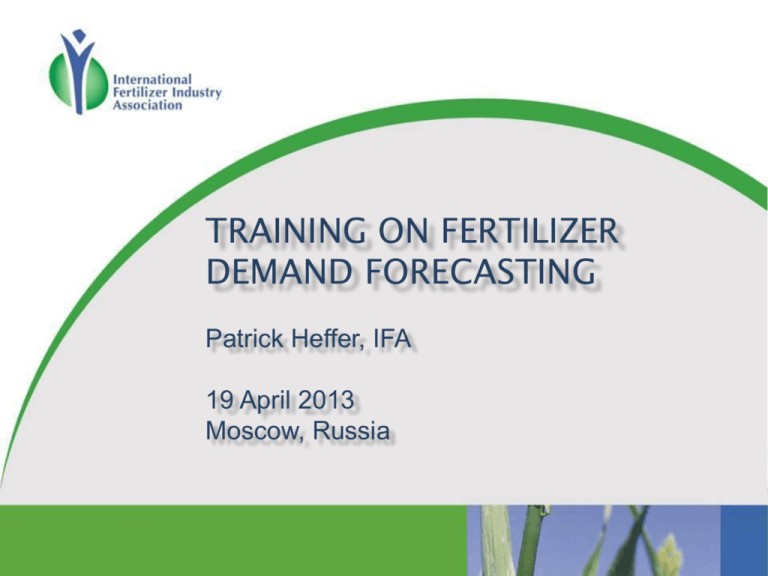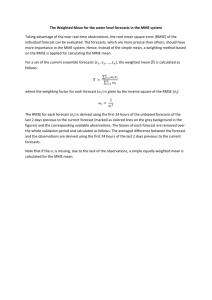Short * Term Prospects For Agricultural Situation and
advertisement

TRAINING ON FERTILIZER DEMAND FORECASTING Patrick Heffer, IFA 19 April 2013 Moscow, Russia What Is IFA? IFA in Brief Non-governmental organization representing the world fertilizer industry About 540 members in 85 countries( including Uralkali and many other Russian fertilizer producers) Based in Paris Organized around three standing committees: o Technical o Production and International Trade o Agriculture Main activities: market analysis, issue management/ advocacy, conference organization IFA Agriculture Committee Four objectives: Address issues facing fertilizer demand Promote the efficient, balanced and responsible use of fertilizers Improve the public image of fertilizers Develop reliable and authoritative fertilizer demand forecasts IFA Agriculture Committee Develop reliable and authoritative fertilizer demand forecasts Reports on demand forecasts twice a year Annual Conference (May/June) medium-term (5-year) forecasts Enlarged Council Meeting (Nov/Dec) short-term (1-year) forecasts Improving the forecasts Develop network of correspondents Guidelines for a crop-based approach Regional training programmes IFA’s Fertilizer Demand Forecasts Methodology and Information Used by IFA Current strategy Rely on information provided by a network of correspondents in ~50 countries Heterogeneous inputs essentially due to different methodologies used depending on the countries Trend forecasts Government objectives Recommended application rates Econometric model (e.g. India, Brazil) Crop-based / expert-based model (e.g. EU, USA) Methodology and Information Used by IFA Correspondents are not enough And checks are needed Use additional sources of info (reports, articles…) on: Economic context, weather, policy factors Global agricultural situation Fertilizer demand forecasts are cross-checked with forecasts on the supply side Check consistency between national forecasts and the global scenario To issue forecasts on the supply/demand balances To ensure consistency between the two sets Forecasts provided by the correspondents are revised in more than half of the countries ! They are almost always revised down. Importance of Good National Forecasts National forecasts are the starting point: They provide the foundation for developing regional and global forecasts Objective High margin of error Mostly over-estimation Small margin of error Balanced fluctuations around actual demand IFA Training Programme on Fertilizer Demand Forecasts Objective - Improve national forecasts, which should result in turn in better regional and global projections Developed guidelines for a crop-based, expert-based forecast On-the-ground training programmes Crop-Based, Expert-Based Forecast Why Is It the Preferred Methodology? What is a Good Forecast? ….. the most likely scenario Independent from: Commercial pressures Governmental objectives Fertilizer recommendations As realistic as possible Not too optimistic over-investments Not too pessimistic would endanger food security Often more conservative than governmental targets Types of Forecast Methodologies Trend analysis Growth rate models Production/trade models Econometric models Crop-based, expert-based models Why Does IFA Recommend Using a Crop-Based, Expert-Based Approach? Can be used on a consistent basis across all the countries and regions Yields much more accurate forecasts than the trend analysis, growth rate models and production/trade models Does not require large databases and knowledge in econometrics as econometric models. Also, more accurate than econometric models Explains where changes in demand are anticipated to come from The Four Stages of a Crop-Based, Expert-Based Forecast The Four Stages Our Goal: “To Arrive at a Realistic, Objective, and Defensible Forecast” Main Steps: I. Create a Historical Database or ‘Base Year’ II. Develop a Qualitative Scenario: Outlook Conditions III. Prepare the Quantitative Forecast IV. Validate the Forecast I. The Historical Database Overview Consists of Data for 3 Forecast Components: 1. Area Planted to Major Crops 2. Percent of Planted Area Fertilized by Nutrient and Crop Type 3. Average Application Rates of Nutrients by Crop Type I. The Historical Database Data Collection 1. Area Planted to Major Crops Identify the Major Nutrient Consuming Crops Develop a Database: • Major Crops • Other Crops Potential Problems • Only Harvested Area Data is Available • Data Only Available for Some/Few Crops Nutrient Use – Major U.S. Crops U.S. Nutrient Use by Crop, FY2004/05 50 45 44 43 41 40 68% 76% NITROGEN PHOSPHATE 35 73% POTASH 25 19 20 17 16 14 15 10 6 5 5 5 5 2 Cotton Soybeans Wheat Corn Cotton Soybeans Wheat Corn Cotton Soybeans Wheat 0 Corn percent 30 Acres Planted – Major U.S. Crops 100,000 90,000 80,000 70,000 Thousand Acres 60,000 50,000 40,000 30,000 20,000 10,000 0 1970 1972 1974 1976 1978 1980 1982 1984 1986 1988 1990 1992 1994 1996 1998 2000 2002 2004 2006 2008 Corn Wheat Soybeans Cotton Share of Total Fertilizer Consumption by Crop Type in 2010 in Russia wheat + barley + maize + sunflower + sugar beet = 75-80% Source: IFA I. The Historical Database Data Collection 2. Percent of Planted Area Fertilized • Identify Area Fertilized for Each Major Crop • Express as Percent of Planted Area 3. Average Application Rates • Determine Amount of Each Nutrient Applied to Crop • Express in kg/ha Potential Problems • Only Some Data Exists 1984 N P2O5 K2O 2004 2002 2000 1998 1996 1994 1992 1990 1988 1986 1982 1980 1978 1976 1974 1972 1970 1968 1966 1964 Percent Percent of Corn Acres Treated by Nutrient 100 90 80 70 60 50 40 30 20 10 0 1984 N P2O5 K2O 2004 2002 2000 1998 1996 1994 1992 1990 1988 1986 1982 1980 1978 1976 1974 1972 1970 1968 1966 1964 lbs. per treated acre Application Rate per Treated Corn Acre 140 120 100 80 60 40 20 0 1984 N P2O5 K2O 2004 2002 2000 1998 1996 1994 1992 1990 1988 1986 1982 1980 1978 1976 1974 1972 1970 1968 1966 1964 lbs. per acre Average Nutrient Application Rate - Corn 140 120 100 80 60 40 20 0 II. The Qualitative Scenario “What Will the Future Look Like?” Develop Assumptions About Conditions That Will Impact Crop Acreage and Nutrient Application Consider • Domestic and World Economies • Crop Market Conditions • Fertilizer Market Conditions • The Regulatory Environment • Infrastructure Investments or Limitations Avoid • Government/Industry Targets III. The Quantitative Forecast Applying Your Qualitative Conditions “For Each Crop, Consider Impact of Stage II Assumptions on Each Forecast Component”: Area Planted Impacted by: • Crop Prices • Weather • Government Policies • Changes to Demand • Infrastructure III. The Quantitative Forecast Applying Your Qualitative Conditions “For Each Crop, Consider Impact of Stage II Assumptions on Each Forecast Component”: Percent of Area Fertilized and Application Rates Impacted by: • Crop Prices and Yields • Fertilizer Prices and Availability • Soil Type, Moisture, and Weather • Policy Changes IV. Forecast Validation Recall Our Goal: “To Arrive at a Realistic, Objective, and Defensible Forecast” The Final Step: Verify That the Forecast Meets These Criteria 1. Cross Check Results 2. Seek Out Supporting Data 3. Compare to Other Methodologies • Trend Forecast • Econometric Model if Available Once Comfortable With the Forecast, Explain Results Concluding Remarks Maintaining Your Forecast 1. Update Your Stage II Assumptions Regularly 2. Anticipate/Explain Structural Changes • Historical Data • Forecast 3. Compare Results With Others 4. Rely On and Trust Your Own Expertise Your Forecast Will Improve Over Time • Progressive Increase of Crop Coverage • Progressive Improvement of Data Quality Crop-Based, Expert-Based Forecast in Summary Our goal: “to arrive at a realistic, objective, and defensible forecast” 3 variables Main steps: 1. Area planted to major I. Create a historical database crops or ‘base year’ 2. Percent of planted area fertilized by II. Develop a qualitative scenario: nutrient and crop outlook conditions type III. Prepare the quantitative 3. Average application forecast rates of nutrients by crop type IV. Validate the forecast Outlook for World and Regional Fertilizer Demand Note regarding data presented: Short-term outlook of December 2012 Medium-term Outlook of June 2012 World Cereal Production and Utilization (Mt) Balance forecast at the end of the 2012/13 campaign: FAO: -30 Mt USDA: -45 Mt IGC: -45 Mt Source: FAO World Cereal Stock-to-Use Ratio Anticipated ending stock evolution in 2012/13: Wheat: -23 Mt (-12%) Lowest S/U ratio since 2007/08; 2nd lowest since 1980 Major exporters stock-todisappearance: 13.9% Coarse grains: -13 Mt (-8%) Lowest S/U ratio since 1980 Major exporters stock-todisappearance: 8.9%; below 6% in the US Source: FAO Rice: Increase for 6th consecutive year Relative Evolution of Agricultural Commodity Prices Relative Price Evolution from January 2006 to October 2012 Rice Wheat Maize Maize Soybean Soybean Wheat Rice Sources: Financial Times and IMF Global Fertilizer Demand Short-term Forecasts (Mt nutrients) Change 2011/12 2012/13 2013/14 N +3.0% +1.5% +1.5% P2O5 +1.2% -2.7% +3.5% K2O +2.1% +0.1% +4.5% Total +2.4% +0.3% +2.4% Source: IFA Agriculture Reminder on reference years: ~1/2 of the world market: January X December X ~1/6 of the world market: April X March X+1 ~2/6 of the world market: July X June X+1 Global Fertilizer Demand Short-term Forecasts (Mt nutrients) Variation in 2011/12 Variation in 2012/13 Variation in 2013/14 0.0 K20 0.6 1.3 P205 -1.1 0.5 1.4 N 3.2 -2 -1 0 1 1.6 2 3 4 1.6 5 6 Source: IFA Agriculture 7 Regional N Fertilizer Demand Short-term Forecast (Mt N) East Asia South Asia North America Lat. Am. & Carib. W. & C. Europe E. Eur. & C. Asia Africa Variation in 2011/12 Variation in 2012/13 Variation in 2013/14 West Asia Oceania -1 0 1 2 Source: IFA Agriculture 3 Regional P Fertilizer Demand Short-term Forecast (Mt P2O5) East Asia South Asia North America Lat. Am. & Carib. W. & C. Europe E. Eur. & C. Asia Africa Variation in 2011/12 Variation in 2012/13 Variation in 2013/14 West Asia Oceania -1.5 -1.0 -0.5 0.0 0.5 1.0 1.5 Source: IFA Agriculture Regional K Fertilizer Demand Short-term Forecast (Mt K2O) East Asia South Asia North America Lat. Am. & Carib. W. & C. Europe E. Eur. & C. Asia Africa Variation in 2011/12 Variation in 2012/13 Variation in 2013/14 West Asia Oceania -1.5 -1.0 -0.5 0.0 0.5 1.0 1.5 Source: IFA Agriculture 2013/14 vs. 2007/08 (Mt nutrients) N P2O5 K2O East Asia South Asia North America Lat. Am. & Carib. W. & C. Europe E. Eur. & C. Asia Africa West Asia Oceania -3 -2 -1 49% of global net increase 0 1 2 3 4 5 6 7 8 9 10 11 Source: IFA Agriculture Medium-Term Outlook for Agricultural Commodity Prices World Nominal Prices (US$/t) Source: OECD-FAO Global Fertilizer Demand Medium-term Outlook (Mt nutrients) Base year Average Annual Change Base Year 2016/17 N +1.5% p.a. P2O5 +2.3% p.a. K2O +3.7% p.a. Total +2.1% p.a. Source: IFA Agriculture Regional Fertilizer Consumption Medium-term Outlook (Mt nutrients) East Asia 30% South Asia 24% North America Lat. Am. & Carib. 21% W. & C. Europe E. Eur. & C. Asia 6% West Asia Av. 2009/10 to 2011/12 Africa Variation in 2016/17 Oceania 0 10 20 30 40 50 60 70 Source: IFA Agriculture 80 for more information: www.fertilizer.org








